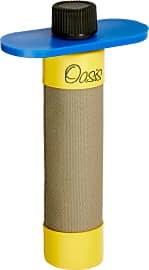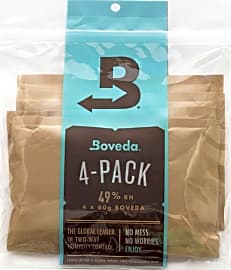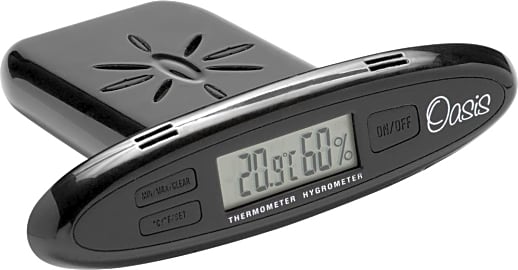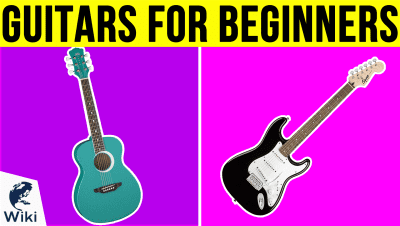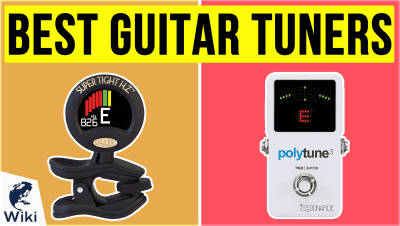The 10 Best Guitar Humidifiers

This wiki has been updated 37 times since it was first published in February of 2017. Separations, cracks, loose bridges and neck joints, changes in sound -- these are only a handful of the misfortunes that could befall your beloved guitar in a dry environment. But you can prevent these issues with a humidifier, which is designed to keep the air inside your instrument optimally moist. Many come with a hygrometer, too, for measuring the moisture level in the air. When users buy our independently chosen editorial picks, we may earn commissions to help fund the Wiki.
Editor's Notes
October 04, 2019:
To accommodate all needs (and budgets), we've kept a wide selection for everything from your most expensive guitars to guitars for beginners that may not be as delicate. For most, the Music Nomad Premium and D’Addario Restore Kit remain fine options, as they aren't hard to use but produce relatively consistent results. We've also opted to add the Dampit Original Super, which is now sold as an updated clip-less version. It hangs between the strings, rendering the clip unnecessary. We've selected one whole-room humidifier, the TaoTronics Top Fill, as well. For some, this might be overkill, but if you happen to have a few guitars and don't mind monitoring the air in the room, it could work. You'll probably want to purchase a separate hygrometer to make sure you aren't overdoing it, though.
Special Honors
Humistat Adjustable Hygrometer Kit The Humistat Adjustable Hygrometer Kit is a simple and effective option. After filling the unit, simply turn the dial on the side to change the amount of humidification, then place both it and the hygrometer in your case at any orientation. humistat.com
The Importance Of Humidity For Wooden Instruments
Depending on where you live, you might not need to use your humidifier all year round.
If you own an acoustic guitar, you may have noticed a change in the quality of its sound depending on the time of year, particularly if you live in a climate with seasonal extremes. That’s because wood has the ability to expand and contract with changes in humidity.
In very dry environments, the water that’s bound up in the wood cells actually evaporates, causing the individual cells to shrink. To help you picture what’s going on here, you can imagine a sponge. When a sponge is left out and the water in it evaporates, it gets smaller. Conversely, when wood or a sponge is in a wet environment, it will expand.
For a sensitive instrument like a guitar, neither too wet nor too dry is ideal. In an environment that’s too wet, the wood can warp and even begin to grow mold. This can dramatically, and often irreversibly, damage the instrument. Those high levels of humidity are a little more rare, however, and simply leaving a guitar in its case can often protect it against aggressive moisture.
If the environment is too dry, leaving your guitar in its case might help, but you want to make sure that the wood doesn’t run the risk of shrinking so much that it becomes brittle or develops cracks. Using a guitar humidifier is the best way to ensure that your instrument is kept at the optimal levels of moisture to preserve its tone and extend its life.
Most humidifiers work by introducing a controlled amount of moisture to the inside of a guitar, where the instrument is most vulnerable. The outside of most acoustic guitars is finished with a sealant that can protect it from the elements, but the inside is often left unfinished. That unfinished wood surface is where the lion’s share of evaporation occurs. That’s why most humidifiers hang through the sound hole of the instrument, allowing moisture to protect the unfinished wood.
Depending on where you live, you might not need to use your humidifier all year round. In very moist climates that aren’t particularly hot, you may find yourself leaving the air conditioner off in favor of a ceiling fan or floor fan, and an environment like this is fine for most guitars. It’s the dry climates and the arid winter months that pose the most risk, however, as most household heating systems sap a tremendous amount of moisture from the air. With a guitar humidifier during this season, you can keep your feet all toasty and warm without risking the health of your instrument.
Which Guitar Humidifier Is Right For You?
Knowing that a guitar humidifier is necessary is only half the battle. Now, you have to figure out which model will best suit your guitar, your environment, and your lifestyle. Fortunately, these solutions are inexpensive enough that you could probably swing and miss with your first choice or two, and it won’t break the bank.
Of course, that doesn’t mean you shouldn’t try to get the best thing for your situation right out of the gate. To do that, you need to see what makes one choice different from another, and consider how you might enjoy using it.
Now, you have to figure out which model will best suit your guitar, your environment, and your lifestyle.
For example, there are guitar humidifiers out there that are stunningly simple. They feature sponge inserts that you only have to moisten once a week or so. They hang out in your guitar, easily getting the job done, and they’re very inexpensive. If you’re a frequent player, however, some of the cheaper options out there can leak a little when you take them out of your guitar and set them down somewhere during a jam session.
The more expensive guitar humidifiers out there earn their price tags by offering leak-proof sponge containers, among other features. They tend to be more durable, so they make good choices for touring musicians, as well.
Some of those more expensive units also provide you with feedback about the humidity level inside your instrument. These devices are called hygrometers, and they can measure the humidity in a given space with very high accuracy. Some units come with separate hygrometers for you to keep an eye on the humidity inside your guitar, while others have their hygrometers built into the sponge hanging system. If you’re particularly anal about taking care of your instrument, and you often bring it to environments of varying humidity levels, these are the best options for you.
Other Easy Ways To Care For Your Guitar
While maintaining optimal humidity levels for your guitar is one of the most important things you can do to keep it healthy and sounding great, there are a couple of other tricks and tools you can use to ensure its well-being. These are applicable to electric and acoustic guitars alike, so you can apply them to your entire arsenal.
If you really want to do it yourself, ask to watch him or her work, and take as many mental notes as possible before trying it out on your own guitar.
One of the best things you can do for the guitar you keep at home is ditch the standard guitar stand, and invest in a wall hanger for each and every ax you own. This puts pressure on the neck joints that works against the pulling force of the strings, so the neck of the instrument will stay straighter longer and need fewer truss rod adjustments over time. It also has the added bonus of turning your guitars into showpieces, artfully hung on the walls for all to see.
To further protect your guitar’s neck alignment, make sure you drastically detune the instrument whenever you’re going to be away from it for an extended period. This will work to ease tension on the neck, even if it’s packed up in storage. When you’re actively playing, make sure you wipe down the strings and neck with a good microfiber cloth after each session to keep your sweat and natural oils from slowly degrading the neck’s wood. This practice can also increase the life of your strings.
Finally, if you suspect that your truss rod needs an adjustment, or that you need to relevel your bridge saddles, by all means, take the thing to a professional. If you really want to do it yourself, ask to watch him or her work, and take as many mental notes as possible before trying it out on your own guitar.





